PORSCHE 911 CARRERA 2011 6.G Information Manual
Manufacturer: PORSCHE, Model Year: 2011, Model line: 911 CARRERA, Model: PORSCHE 911 CARRERA 2011 6.GPages: 63, PDF Size: 9.45 MB
Page 11 of 63
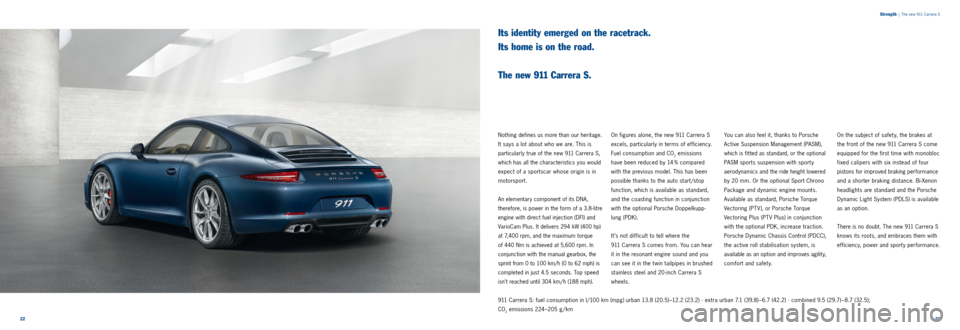
2223
Strength
| The new 911 Carrera S
Its identity emerged on the racetrack.
Its home is on the road.
The new 911 Carrera S.
Nothing defines us more than our heritage.
It says a lot about who we are. This is
particularly true of the new 911 Carrera S,
which has all the characteristics you would
expect of a sportscar whose origin is in
motorsport.
An elementary component of its DNA,
therefore, is power in the form of a 3.8-litre
engine with direct fuel injection (DFI) and
VarioCam Plus. It delivers 294 kW (400 hp)
at 7,400 rpm, and the maximum torque
of 440 Nm is achieved at 5,600 rpm. In
conjunction with the manual gearbox, the
sprint from 0 to 100 km/h (0 to 62 mph) is
completed in just 4.5 seconds. Top speed
isn’t reached until 304 km/ h (188 mph).
On figures alone, the new 911 Carrera S
excels, particularly in terms of efficiency.
Fuel consumption and CO
2 em issio ns
have been reduced by 14 % compared
with the previous model. This has been
possible thanks to the auto start /stop
function, which is available as standard,
and the coasting function in conjunction
with the optional Porsche Doppelkupp -
lung (PDK).
It ’s not difficult to tell where the
911 Carrera S comes from. You can hear
it in the resonant engine sound and you
can see it in the t win tailpipes in brushed
stainless steel and 20 - inch Carrera S
wheels. You can also feel it, thanks to Porsche
Active Suspension Management (PASM),
which is fit ted as standard, or the optional
PASM sports suspension with sport y
aerodynamics and the ride height lowered
by 20 mm. Or the optional Sport Chrono
Package and dynamic engine mounts.
Available as standard, Porsche Torque
Vectoring (PTV), or Porsche Torque
Vectoring Plus (PTV Plus) in conjunction
with the optional PDK, increase traction.
Porsche Dynamic Chassis Control (PDCC),
the active roll stabilisation system, is
available as an option and improves agility,
comfort and safet y. On the subject of safet y, the brakes at
the front of the new 911 Carrera S come
equipped for the first time with monobloc
fixed calipers with six instead of four
pistons for improved braking performance
and a shorter braking distance. Bi-Xenon
headlights are standard and the Porsche
Dynamic Light System (PDLS) is available
as an option.
There is no doubt. The new 911 Carrera S
knows its roots, and embraces them with
efficiency, power and sporty performance.
911 Carrera S: fuel consumption in l/100 km (mpg) urban 13.8 (20.5) –12.2 (23.2) · extra urban 7.1 (39.8) – 6.7 (42.2) · combined 9.5 (29.7) –8.7 (32.5);
CO
2 emissions 224–205 g / km
Page 12 of 63
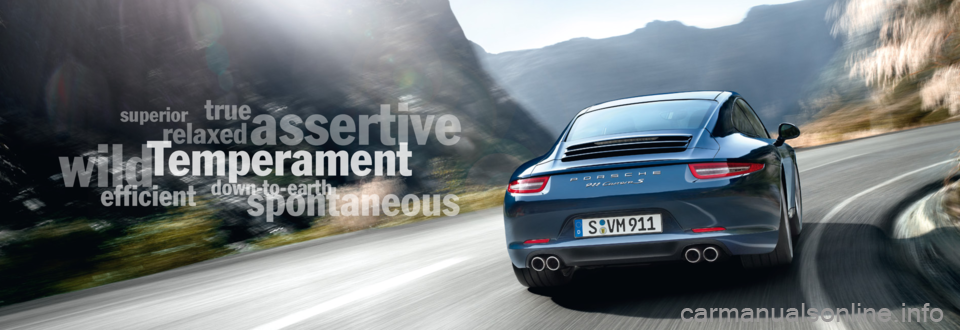
ef\037cient
wild
relaxed
superior
true
spontaneous
assertive
down-to-
T
Page 13 of 63

2627
Temperament
|
Engines
To give more and take less.
That’s Porsche engineering.
Engines.
You could ask whether the sportscar is
still relevant. It would be a good question,
but you might as well ask the same of
dreams.
The answer to both questions lies in
the future or, to be more precise, in the
future of the sportscar. In the new 911,
the future has already begun. The highly
ef ficient, state - of-the -art engines make
a considerable contribution to reducing
fuel consumption, but their sound is still
unmistakably Porsche. The new 911 engines are also unmistaka
-
bly sport y thanks to the new SPORT
but ton fit ted as standard. At the push
of a button, the engine becomes tuned
for a sharper response and engine
dynamics that are even more direct.
The 3.4-litre engine of the new
911 Carrera demonstrates, therefore,
that performance and efficiency need
not be mutually exclusive. Rather, the
downsized engine capacity and increased
maximum torque are the intelligent basis
by which power output can be increased
in an environmentally acceptable and
sustainable way. Fuel consumption and CO2 emissions have been reduced
by up to 16 % compared with the previous
model.
In their search for improved efficiency,
our engineers analysed an extensive
series of engine components. Answers
were found, including rapid heating
of the engine and gearbox by the new
thermal management after an engine
start, optimised air induction and the
extremely effective direct fuel injection
(DFI).
The same principle applies to the 3.8-litre
engine in the 911 Carrera S. There has been no change in displacement since
the previous model, but power output has
been increased while fuel consumption
has been reduced by up to 14 %.
Weight is critical to efficiency. This is
why the engines have a light-alloy
construction, which makes them light -
weight and structurally rigid for improved
fuel economy and a long life.
The engine is the intelligent core of our
identit y. What else could the ‘Dr. Ing.’ in
our company name possibly stand for?
911 Carrera models: fuel consumption in l/100 km (mpg) urban 13,8 (20.5) –11.2 (25.2) · extra urban 7.1 (39.8) – 6.5 (43.5) · combined 9.5 (29.7) –8.2 (34.4);
CO
2 emissions 224–194 g / km
Page 14 of 63
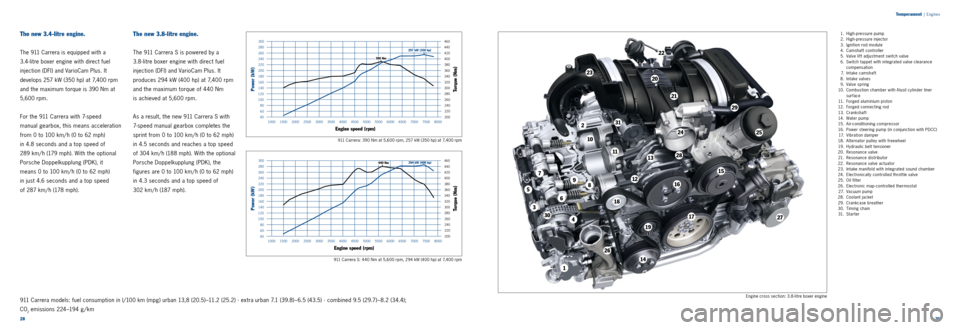
1
2
3
4
5
6
7
89
10
11
12
13
14
15
16
17
18
19
20
21
22
23
2425
26
27
28
29
30
31
2829
Temperament
|
Engines
Engine cross section: 3.8-litre boxer engine
911 Carrera S: 440 Nm at 5,600 rpm, 294 kW (400 hp) at 7,400 rpm
1. High - pressure pump
2. High-pressure injector
3. Ignition rod module
4. Camshaft controller
5. Valve lif t adjustment switch valve
6. Switch tappet with integrated valve clearance
compensation
7. Intake camshaf t
8. Intake valves
9. Valve spring
10. Combustion chamber with Alusil cylinder liner
surface
11. Forged aluminium piston
12. Forged connecting rod
13. Crankshaft
14. Water pump
15. Air-conditioning compressor
16. Power steering pump (in conjunction with PDCC)
17. Vibration damper
18. Alternator pulley with freewheel
19. Hydraulic belt tensioner
20. Resonance valve
21. Resonance distributor
22. Resonance valve actuator
23. Intake manifold with integrated sound chamber
24. Electronically controlled throttle valve
25. Oil filter
26. Electronic map-controlled thermostat
27. Vacuum pump
28. Coolant jacket
29. Crankcase breather
30. Timing chain
31. S t a r t e r
911 Carrera: 390 Nm at 5,600 rpm, 257 kW (350 hp) at 7,400 rpm
The new 3.4-litre engine.
The 911 Carrera is equipped with a
3.4-litre boxer engine with direct fuel
injection (DFI) and VarioCam Plus. It
develops 257 kW (350 hp) at 7,400 rpm
and the maximum torque is 390 Nm at
5,600 rpm.
For the 911 Carrera with 7-speed
manual gearbox, this means acceleration
from 0 to 100 km/ h (0 to 62 mph)
in 4.8 seconds and a top speed of
289 km/ h (179 mph). With the optional
Porsche Doppelkupplung (PDK), it
means 0 to 100 km/ h (0 to 62 mph)
in just 4.6 seconds and a top speed
of 287 km/ h (178 mph).
The new 3.8-litre engine.
The 911 Carrera S is powered by a
3.8-litre boxer engine with direct fuel
injection (DFI) and VarioCam Plus. It
produces 294 kW (400 hp) at 7,400 rpm
and the maximum torque of 440 Nm
is achieved at 5,600 rpm.
As a result, the new 911 Carrera S with
7-speed manual gearbox completes the
sprint from 0 to 100 km/ h (0 to 62 mph)
in 4.5 seconds and reaches a top speed
of 304 km/ h (188 mph). With the optional
Porsche Doppelkupplung (PDK), the
figures are 0 to 100 km/ h (0 to 62 mph)
in 4.3 seconds and a top speed of
302 km/ h (187 mph).
911 Carrera models: fuel consumption in l/100 km (mpg) urban 13,8 (20.5) –11.2 (25.2) · extra urban 7.1 (39.8) – 6.5 (43.5) · combined 9.5 (29.7) –8.2 (34.4);
CO
2 emissions 224–194 g / km
40 60 80
100
120 140 160 180 200 220 240 260
1500 75008000
2000 2500300035004000450050005500600065007000
1000
294 kW (400 hp)440 Nm
300
280
Power (kW)
T orque (Nm)
Engine speed (rpm)
200
280 300 320 340 360 380 400 420
220 240 260
460
440
40
60 80
100 120 140 160 180 200 220 240 260
1500 75008000
2000 2500300035004000450050005500600065007000
1000
300
280
Power (kW)
T orque (Nm)
Engine speed (rpm)
200
280 300 320 340 360 380
400 420
220 240 260
460
440
257 kW (350 hp)
390 Nm
Page 15 of 63
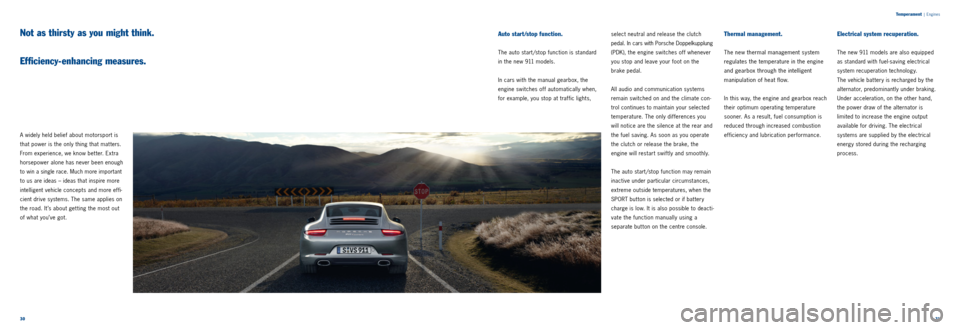
3031
A widely held belief about motorsport is
that power is the only thing that mat ters.
From experience, we know bet ter. Extra
horsepower alone has never been enough
to win a single race. Much more important
to us are ideas – ideas that inspire more
intelligent vehicle concepts and more ef fi-
cient drive systems. The same applies on
the road. It ’s about get ting the most out
of what you’ve got. select neutral and release the clutch
pedal. In cars with Porsche Doppel
kupplung
(PDK), the engine switches off whenever
you stop and leave your foot on the
brake pedal.
All audio and communication systems
remain switched on and the climate con -
trol continues to maintain your selected
temperature. The only differences you
will notice are the silence at the rear and
the fuel saving. As soon as you operate
the clutch or release the brake, the
engine will restart swiftly and smoothly.
The auto start/stop function may remain
inactive under particular circumstances,
extreme outside temperatures, when the
SPORT but ton is selected or if bat tery
charge is low. It is also possible to deacti -
vate the function manually using a
separate but ton on the centre console.
Thermal management.
The new thermal management system
regulates the temperature in the engine
and gearbox through the intelligent
manipulation of heat flow.
In this way, the engine and gearbox reach
their optimum operating temperature
sooner. As a result, fuel consumption is
reduced through increased combustion
efficiency and lubrication performance.
Electrical system recuperation.
The new 911 models are also equipped
as standard with fuel-saving electrical
system recuperation technology.
The vehicle bat tery is recharged by the
alternator, predominantly under braking.
Under acceleration, on the other hand,
the power draw of the alternator is
limited to increase the engine output
available for driving. The electrical
systems are supplied by the electrical
energy stored during the recharging
process.
Temperament | Engines
Auto start/stop function.
The auto start/stop function is standard
in the new 911 models.
In cars with the manual gearbox, the
engine switches off automatically when,
for example, you stop at traffic lights,
Not as thirsty as you might think.
Efficiency- enhancing measures.
Page 16 of 63

3233
DFI delivers fuel directly into the combustion
chamber with millisecond precision. The
spray and cone angles of the new multi-
hole injectors have been optimised for
torque, power output, fuel consumption,
emissions and ef ficient combustion.
With direct injection, the engine manage-
ment system regulates injection timing
individually for each cylinder as well as
the injection rate for each cylinder bank.
This optimises the combustion process
and fuel economy. The system first dif ferentiates
bet ween driver inputs that t ypify normal,
everyday driving and those inputs
that demand maximum performance.
The electronic engine management
system then seamlessly adapts valve
operation to the prevailing conditions.
This results in instant acceleration,
extremely smooth running and an
extraordinary level of tractive power,
but with a comparatively low level of
fuel consumption.
For faster heating of the catalytic converters
after a cold start and optimum torque in
the upper load range, up to three injection
pulses take place per combustion cycle.
DFI improves the internal cooling of
the combustion chamber by having the
mixture prepared directly in the cylinder.
This allows for a higher compression
ratio, which helps to deliver more output
at the same time as enhanced engine
efficiency. Injection is regulated by the
electronic engine management system
Temperament | Engines
and emissions are monitored by the
Lambda sensors, thus helping to protect
the environment.
VarioCam Plus System.
VarioCam Plus is a two-in-one engine
concept for adjusting the intake
camshafts and switching the lift of the
intake valves.
What lies between your home and Le Mans?
Advanced engineering as standard.
Direct fuel injection (DFI).
Page 17 of 63
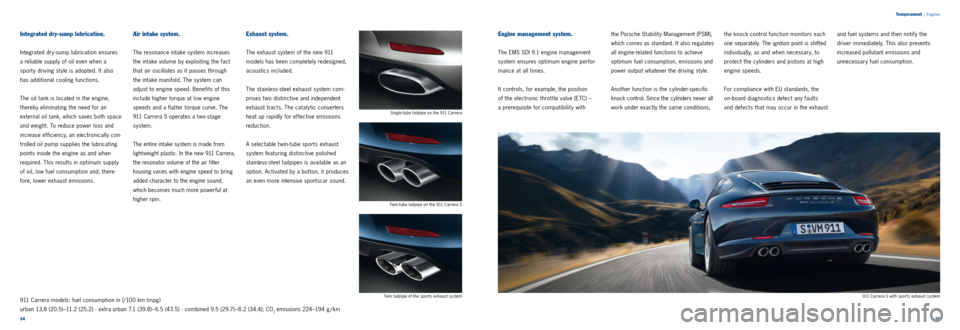
3435
Temperament
|
Engines
Integrated dry-sump lubrication.
Integrated dr y-sump lubrication ensures
a reliable supply of oil even when a
sport y driving st yle is adopted. It also
has additional cooling functions.
The oil tank is located in the engine,
thereby eliminating the need for an
external oil tank, which saves both space
and weight. To reduce power loss and
increase efficiency, an electronically con -
trolled oil pump supplies the lubricating
points inside the engine as and when
required. This results in optimum supply
of oil, low fuel consumption and, there -
fore, lower exhaust emissions.
Air intake system.
The resonance intake system increases
the intake volume by exploiting the fact
that air oscillates as it passes through
the intake manifold. The system can
adjust to engine speed. Benefits of this
include higher torque at low engine
speeds and a flat ter torque curve.
The
911 Carrera S operates a t wo -stage
system.
The entire intake system is made from
light weight plastic. In the new 911 Carrera,
the resonator volume of the air filter
housing varies with engine speed to bring
added character to the engine sound,
which becomes much more powerful at
higher rpm.
Exhaust system.
The exhaust system of the new 911
models has been completely redesigned,
acoustics included.
The stainless-steel exhaust system com -
prises t wo distinctive and independent
exhaust tracts. The cataly tic converters
heat up rapidly for effective emissions
reduction.
A selectable t win -tube sports exhaust
system featuring distinctive polished
stainless-steel tailpipes is available as an
option. Activated by a but ton, it produces
an even more intensive sportscar sound.
911 Carrera S with sports exhaust system
Engine management system.
The EMS SDI 9.1 engine management
system ensures optimum engine perfor -
mance at all times.
It controls, for example, the position
of the electronic throt tle valve (ETC) –
a prerequisite for compatibility with the Porsche Stabilit y Management (PSM),
which comes as standard. It also regulates
all engine-related functions to achieve
optimum fuel consumption, emissions and
power output whatever the driving st yle.
Another function is the cylinder-specific
knock control. Since the cylinders never all
work under exactly the same conditions, the knock control function monitors each
one separately. The ignition point is shifted
individually, as and when necessary, to
protect the cylinders and pistons at high
engine speeds.
For compliance with EU standards, the
on - board diagnostics detect any faults
and defects that may occur in the exhaust and fuel systems and then notify the
driver immediately. This also prevents
increased pollutant emissions and
unnecessary fuel consumption.
Twin tailpipe of the sports exhaust system Single-tube tailpipe on the 911 Carrera
Twin-tube tailpipe on the 911 Carrera S911 Carrera models: fuel consumption in l/100 km (mpg)
urban 13,8 (20.5) –11.2 (25.2) · extra urban 7.1 (39.8) – 6.5 (43.5) · combined 9.5 (29.7) –8.2 (34.4); CO
2 emissions 224–194 g / km
Page 18 of 63
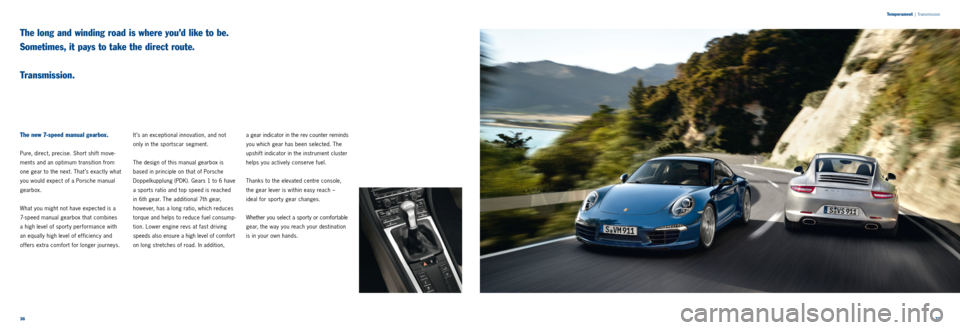
3637
Temperament
|
Transmission
The long and winding road is where you’d like to be.
Sometimes, it pays to take the direct route.
Transmission.
The new 7-speed manual gearbox.
Pure, direct, precise. Short shif t move -
ments and an optimum transition from
one gear to the next. That ’s exactly what
you would expect of a Porsche manual
gearbox.
What you might not have expected is a
7-speed manual gearbox that combines
a high level of sport y performance with
an equally high level of efficiency and
offers extra comfort for longer journeys. It’s an exceptional innovation, and not
only in the sportscar segment.
The design of this manual gearbox is
based in principle on that of Porsche
Doppelkupplung (PDK). Gears 1 to 6 have
a sports ratio and top speed is reached
in 6th gear. The additional 7th gear,
however, has a long ratio, which reduces
torque and helps to reduce fuel consump -
tion. Lower engine revs at fast driving
speeds also ensure a high level of com
fort
on long stretches of road. In addition
, a gear indicator in the rev counter reminds
you which gear has been selected. The
upshift indicator in the instrument cluster
helps you actively conserve fuel.
Thanks to the elevated centre console,
the gear lever is within easy reach –
ideal for sport y gear changes.
Whether you select a sporty or comfortable
gear, the way you reach your destination
is in your own hands.
Page 19 of 63

462135
7R
3839
Porsche Doppelkupplung (PDK).
Available as an option for the new 911
models is 7-speed PDK, featuring manual
and automatic modes. This double - clutch
transmission has been further refined and
enables extremely fast gear changes with
no interruption in the flow of power, which vastly improves acceleration at the
same time as reducing fuel consumption.
In total, PDK has seven gears at its disposal.
Gears 1 to 6 have a sports ratio and top
speed is reached in 6th gear. 7th gear has
a long ratio and helps to reduce fuel
consumption by keeping engine revs low.
Porsche Doppelkupplung (PDK)
PDK is essentially t wo gearboxes in one
and thus requires t wo clutches. This
double-clutch arrangement provides an
alternating, non-positive connection
bet ween the t wo half gearboxes and the
engine by means of t wo separate input
shafts.The flow of power from the engine is
transmit ted through one half gearbox and
one clutch at a time, while the next gear
is preselected in the second half gearbox.
During a gear change, therefore, one
clutch simply opens and the other closes
at the same time, enabling gear changes
to take place within milliseconds.
Temperament | Transmission
The effect is instant. Driving feels even
sportier and more dynamic, and agility
is increased. Depending on the gearshift
programme (SPORT button activated
or deactivated), the gear change is opti -
mised for comfort or for sport y driving.With the optional Sport Chrono Package,
PDK is enhanced by the ‘Launch Control’
and ‘motorsport- derived gearshif t strategy’
functions (p. 50). In this way, optimum use is made of the
vehicle’s momentum, allowing it to coast
for longer distances.
For example, you may want to slow down
from 100 km/ h (62 mph) to 80 km/ h
(49 mph) in anticipation of the change of
speed limit ahead. As soon as you release
the accelerator pedal, PDK deselects
the current gear automatically and you
begin to coast in neutral until you have
reached your desired speed. The moment
you engage the accelerator or brake
pedal, PDK selects the appropriate gear
smoothly and seamlessly within a fraction
of a second.
Another way to reduce fuel consumption is
to utilise the coasting function on downhill
gradients that are gentle enough for you
to maintain a constant speed. Efficient on
long journeys, such as on the motorway,
PDK remains ready to respond as swiftly
and precisely as you would expect.
In short, driving in coasting mode makes
a real impact on fuel consumption without
any need for compromise on comfort or
sporty performance.
Coasting.
The ‘coasting’ function available with
Porsche Doppelkupplung (PDK) enables
you to save even more fuel where the
situation allows. The engine is decoupled
from the transmission to prevent
deceleration caused by engine braking.
Page 20 of 63
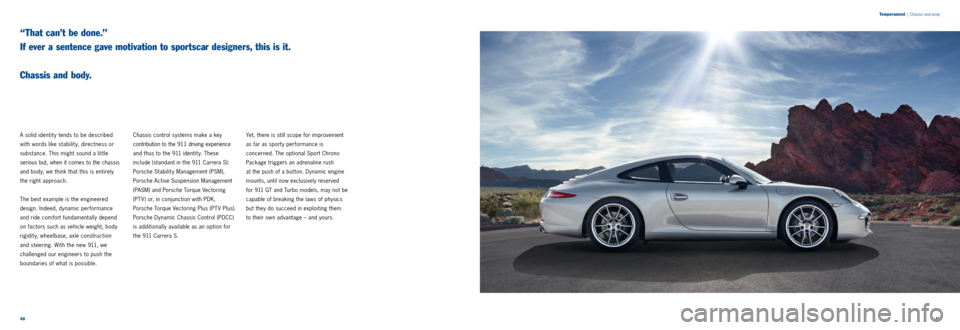
4041
Temperament
| Chassis and body
“That can’t be done.”
If ever a sentence gave motivation to sportscar designers, this is it.
Chassis and body.
A solid identit y tends to be described
with words like stability, directness or
substance. This might sound a lit tle
serious but, when it comes to the chassis
and body, we think that this is entirely
the right approach.
The best example is the engineered
design. Indeed, dynamic per formance
and ride comfort fundamentally depend
on factors such as vehicle weight, body
rigidity, wheelbase, axle construction
and steering. With the new 911, we
challenged our engineers to push the
boundaries of what is possible. Chassis control systems make a key
contribution to the 911 driving experience
and thus to the 911 identit y. These
include (standard in the 911 Carrera S):
Porsche Stability Management (PSM),
Porsche Active Suspension Management
(PASM) and Porsche Torque Vectoring
(PTV) or, in conjunction with PDK,
Porsche Torque Vectoring Plus (PTV Plus).
Porsche Dynamic Chassis Control (PDCC)
is additionally available as an option for
the 911 Carrera S. Yet, there is still scope for improvement
as far as sport y performance is
concerned. The optional Sport Chrono
Package triggers an adrenaline rush
at the push of a but ton. Dynamic engine
mounts, until now exclusively reserved
for 911 GT and Turbo models, may not be
capable of breaking the laws of physics
but they do succeed in exploiting them
to their own advantage – and yours.